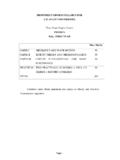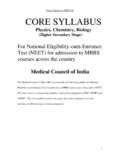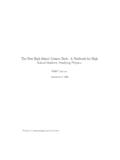Transcription of Revealing the nature of the final image in Newton's ...
1 Revealing the nature of the final image in newton sexperimentumcrucisSaschaGruschea)Physik didaktik, P adagogische Hochschule Weingarten, 88250 Weingarten, Germany(Received 7 July 2014; accepted 4 April 2015)In his crucial prism experiment, newton noted the position of the final image , but not its shape orcoloring. Most scholars describe the image as a single-colored representation of the selectiveaperture; some report multiple colors. When the experiment is re-enacted as the transformation of acamera obscuraimage, it becomes clear that the final image is a rainbow-colored representation ofthe outside world. Backward ray tracing enhances newton s demonstration of diverserefrangibility.
2 Using a projector, teachers can easily bring this historical experiment into theclassroom and build a bridge to modern applications in hyperspectral imaging and American Association of Physics Teachers.[ ]I. INTRODUCTIONN ewton sexperimentum crucis1 5is a well-known opticsexperiment;6 18see , newton s firststep was to refract a narrow beam of sunlight with a prism,obtaining a long, rainbow-colored ,3,5 newton under-stood this spectrum as a vertical series of interlocking concluded that sunrays are diverse in the degreeto which they are ,5To prove thisdiverse refrangibil-ity, newton took a second step: Turning the first prism to andfro, he passed different parts of the spectrum through a selec-tive aperture and a second prism.
3 Looking for diverse refrangi-bility, newton observed the finalimageonlywithregardtoitsdiverse positions;1,5its shape and coloring were irrelevant tohim. In a letter to Pardies,2 newton wrote that the final imagewas more or less in the shape of the selective aperture, but heleft the exact shape to be determined by geometricians. 3 Both in his New Theory 1andinhisOpticks,4the shape andcoloring of the final image are not ,20 24and textbook authors25 27who describetheexperimentum crucisusually believe that the final imageis a single-colored representation of the selective claim that the colors of the spectrum are not split up bythe second prism. This scientific belief14has been handeddown from newton s generation to ,18 However, somescientists have observed multiple colors behind the 30 When newton was challenged to explain thesecolors, he replied that diverse rays come from diverse partsof the sun, and that additional rays could come about the colors of rays, newton and hiscritics ignored the shape of the final in all, descriptions of the final image have been incom-plete and inconsistent.
4 Our purpose here is to clarify theshape and coloring of the final image . To this end, we willreconsider the entire imaging s ray drawings2,5indicate this imaging process( ): Sunrays are refracted, selected, and refracted , the shape of the final image is unclear because the thirddimension is missing. We cannot even assign colors to therays because newton did not draw to scale. To achieve thecorrect proportions, we would need a sketch that is almostlife-sized. Thus, a ray-based approach seems , we will use an image -based approach,9,32,33whichis outlined in In , we apply thisapproach to theexperimentum crucis. In , we turn toan equivalent experiment to validate our view of the finalimage.
5 In , the teacher will find ways to bring theexperimentum crucisinto the classroom, and in ,wehighlight the results and implications of our PRINCIPLES OF AN image -BASED APPROACHTo enjoy the benefits of an image -based approach, we willfollow its three major principles (cf. ,32, and33):Principle I:Watchhow the phenomenon changes as the ex-perimental conditions II:Thinkin terms of images instead of light III:Drawrays only to represent lines of sight, nottrajectories of we apply the first principle successfully, our insightswill be systematic and based on visual experience. Yet howcan we change the experimental conditions without changingNewton s experimental setup? We will achieve this by start-ing with only one optical element, and then adding the otherelements, one by one.
6 newton s description starts with prismP1( ), but we will start a direct application of the second principle, we willbegin with the pinholeHto produce a concrete image . Then,we will put the other elements at their designated places,watching how they successively change the initial imageinto the final image . Thus, we will see more than Newtonsaw, and gain a holistic understanding of the imaging pro-cess. Even newton thought in terms of images when explain-ing the spectrum,19but he thought in terms of rays whendiscussing the light behind the selective ,3,5,31 The third principle allows us to interpret the imaging pro-cess in terms of rays, without speculating about the nature , before we introduce any rays, we will thinkeverything through in terms of FROM INITIAL TO final IMAGETo understand the shape and coloring of the final image ,we will re-enact newton sexperimentum crucisas the crea-tion and transformation of acamera J.
7 (7), July 2015 American Association of Physics Teachers583A. Through the pinhole:Camera obscuraprojectionHaving darkened his study room, newton makes a widehole in the window shutter and puts behind it a board piercedwith a ,3,5 Literally, he has turned his room into acamera obscura(Latin for dark chamber), or pinhole cam-era. Realizing that each of our eyes is acamera obscura,too,17we can understand what is projected inside newton schamber: an upside-down representation of the view fromthe pinhole ( ). Although we can see trees, meadows,houses, and the sky, newton mentions only the solar disk1[ (a)].Fig. 1. newton s drawings of hisexperimentum crucis. (There is no suchdrawing in his New Theory ( ).)
8 For the notation, see TableI. (a)From a letter to Pardies, 1672 ( ). (Read drawing from left to right.)The prisms are mutually inverted; the final rays hardly diverge. (b) FromOpticks, 1704 ( ). (Read drawing from right to left.) The prisms arenon-inverted; the final rays clearly I. Notation for optical elements, cf. elementNewton 1672 ( ) newton 1704 ( ) GruscheFirst prismAABCP1 Pinholex(inBC)G(inDE)HSelective aperturey(inDE)g(inde)ASecond prismFabcP2 Fig. 2. (Color online) Unenhanced photo of the setup for newton sexperi-mentum crucis. The first prismP1, hidden by the board with pinholeH,isinthe position of minimum deviation, as in (b), so that the rainbow-colored spectrum is projected to the lowest possible position.
9 The selectiveapertureAand the second prismP2are 12 feet away fromP1andH( ). (To reveal the refracted light beams, flour was thrown into the air.)Fig. 3. (Color online) newton s room-sizedcamera obscuraproduces anupside-down image of the Woolsthorpe countryside. Original projection ontranslucent paper, photographed from behind with a Canon EOS 7D; expo-sure time: 8 s 4. (Color online) image transformation in newton sexperimentum cru-cis. (a) The pinhole makes an image of the solar disk [cf. ]. The firstprism spreads the white circle into a series of differently colored circles( ). Different circles contribute different horizontal strips of the solardisk to the selective aperture, here a horizontal slit.
10 (c) Plotting circle posi-tion versus wavelength, we obtain a dispersion diagram (for the symmetryaxis of the spectrum) ( ). The selected segment of the dispersion dia-gram is vertically sheared upon dispersion by the second prism ( ),which is inverted in (d) and not inverted in (e). Correspondingly, theselected strips of the solar disk are shifted apart according to wavelength,forming a multicolored, elliptical image of the sun. ( newton s hole a spe-cial case of our slit yields a vertical strip of that image .)584Am. J. Phys., Vol. 83, No. 7, July 2015 Sascha Grusche584B. Through the first prism: Dispersed imageNext, newton puts a prism in front of the ,3,5 Still, we have acamera obscuraprojection.






